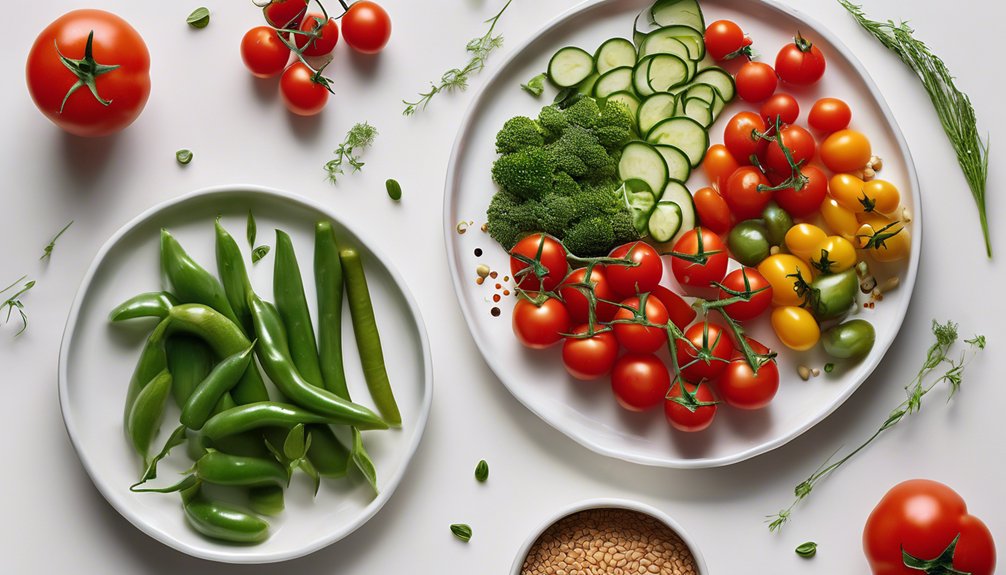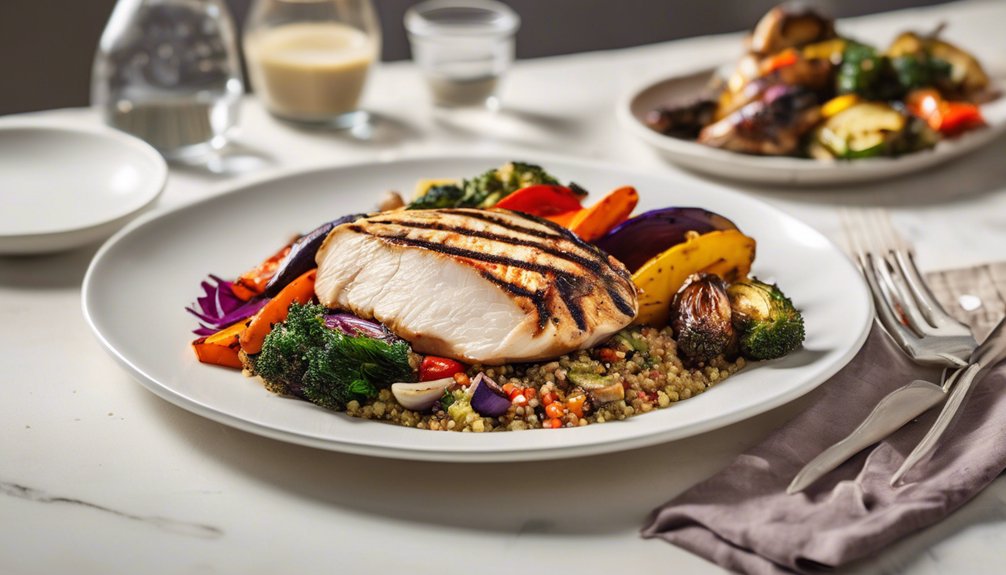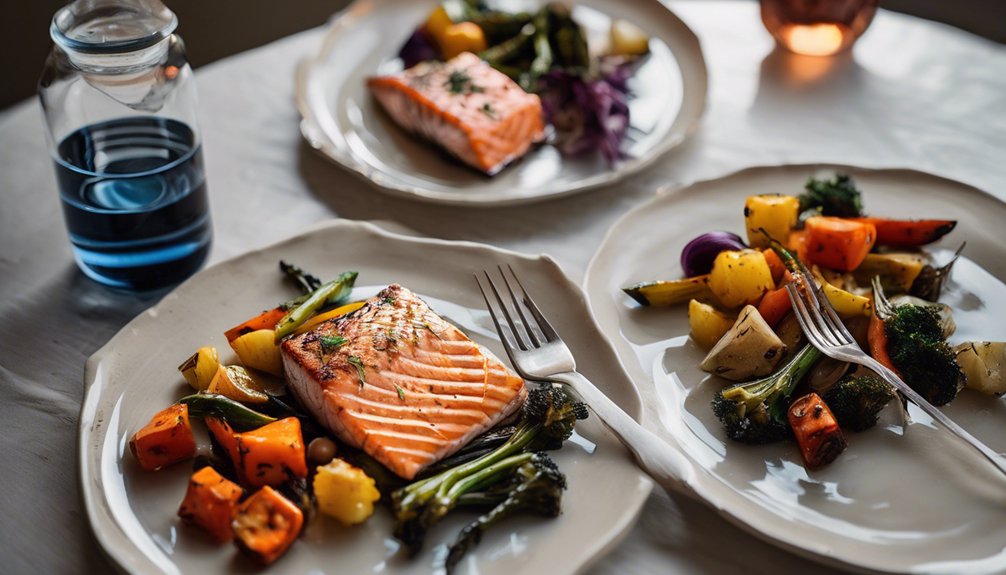Portion Control for Weight Loss Success
Did you know that portion sizes have increased dramatically over the past few decades, contributing to weight gain for many? By understanding and managing your portions, you can take significant steps toward achieving your weight loss goals. Learning how to measure and control your food intake can help you become more mindful of what you eat. Discovering effective strategies for portion control could be the key to your success.
Key Takeaways
- Invest in a digital kitchen scale and measuring cups to accurately portion food and track intake effectively.
- Use portion control plates to visually separate food groups and maintain balanced meals for weight loss.
- Practice mindful eating by slowing down and savoring each bite, enhancing awareness of hunger and fullness cues.
- Serve smaller portions and limit distractions during meals to promote intentional eating and reduce the likelihood of overeating.
- Fill half your plate with vegetables, one-quarter with lean proteins, and one-quarter with whole grains to create a balanced meal.
Understanding Portion Sizes: Why They Matter
When you understand portion sizes, you can make more informed choices about what and how much you eat, which is crucial for effective weight loss.
Many people experience portion distortion, where they perceive larger serving sizes as normal, leading to overeating. By recognizing actual serving sizes, you can better gauge how much food you truly need.
This awareness helps you avoid the trap of mindlessly consuming excess calories. Research shows that proper portion control can significantly impact weight management, allowing you to enjoy your favorite foods without guilt.
Embracing these concepts empowers you to take charge of your eating habits, fostering a healthier relationship with food.
Practical Tips for Measuring Portions
To maintain control over your portions, it's essential to have practical measuring techniques at your fingertips.
Using the right measuring tools can make a significant difference in understanding portion sizes and sticking to your goals. Here are some tips to help you out:
- Invest in a digital kitchen scale for accurate weight measurements.
- Use measuring cups to portion out grains, fruits, and veggies.
- Employ portion control plates with designated sections for different food groups.
- Keep a food journal to track what you've eaten and your portion sizes.
- Visualize common portions (e.g., a fist for veggies, a palm for protein) to gauge what's on your plate.
Mindful Eating: Listening to Your Body
Mindful eating allows you to tune into your body's hunger and fullness cues, fostering a healthier relationship with food.
By focusing on each bite, you can better recognize your hunger cues and satisfaction signals, leading to more intentional choices. This practice encourages you to slow down and appreciate flavors, textures, and aromas, making meals feel more satisfying.
When you listen to your body, you learn when you're truly hungry and when you've had enough, preventing overeating. It's about connecting with your needs rather than eating on autopilot.
Embrace this journey of self-discovery, and you'll find that mindful eating not only supports weight loss but also enhances your overall well-being, creating a deeper bond with your body and food.
Strategies to Avoid Overeating
Recognizing your body's hunger signals is just the beginning of your journey to mindful eating; implementing practical strategies can further help you avoid overeating.
Here are some effective approaches to create a supportive food environment and manage emotional triggers:
- Serve smaller portions to encourage mindful eating.
- Eat slowly and savor each bite, allowing time for your body to signal fullness.
- Limit distractions by turning off screens during meals, helping you focus on your food.
- Keep trigger foods out of sight to reduce temptation and prevent mindless snacking.
- Practice emotional awareness by identifying feelings that lead to unnecessary eating.
Creating a Balanced Plate for Weight Loss
Creating a balanced plate is essential for effective weight loss and overall health. By focusing on healthy combinations of foods, you can create meals that nourish your body while keeping your portions in check. Aim to fill half your plate with colorful vegetables, one-quarter with lean proteins, and one-quarter with whole grains. This approach not only promotes satiety but also provides essential nutrients.
Here's a visual representation to guide you:
| Vegetables | Proteins | Whole Grains |
|---|---|---|
| Spinach | Grilled Chicken | Quinoa |
| Broccoli | Tofu | Brown Rice |
| Carrots | Salmon | Barley |
| Bell Peppers | Lentils | Whole Wheat Bread |
| Zucchini | Turkey | Oats |
Embrace these balanced meals for lasting weight loss success.
Frequently Asked Questions
Can I Eat Snacks While Practicing Portion Control?
Absolutely, you can enjoy snacks while practicing portion control! Just choose healthy snack options and focus on mindful eating. This way, you'll satisfy cravings without overindulging, keeping your nutrition balanced and your goals on track.
How Do Emotions Affect Portion Sizes?
Emotions can significantly influence your portion sizes. When you're feeling stressed or sad, you might engage in emotional eating, leading to portion distortion. Recognizing these triggers helps you make mindful choices and regain control over your eating habits.
Are There Apps to Help With Portion Control?
Yes, there are several portion control apps available that help you track calories effectively. They guide you in measuring servings, ensuring you stay mindful of your intake, and support your journey toward healthier eating habits.
What Role Does Hydration Play in Portion Control?
Hydration's like a gentle breeze, guiding you toward mindful drinking. Staying hydrated can curb hunger and promote better portion control, as dehydration often mimics hunger. Prioritizing hydration effects helps you make more conscious eating choices.
How Can I Handle Social Situations Affecting Portion Sizes?
In social situations, you can handle portion sizes by politely declining extra servings. Remember, dining etiquette allows for personal choices. Stand firm against peer pressure; prioritize your health and enjoy the company over the food.
Conclusion
By mastering portion control, embracing mindful eating, and implementing practical strategies, you can empower yourself on your weight loss journey. You'll learn to recognize true hunger, savor every bite, and create balanced meals. Remember, it's not just about what you eat, but how much you eat. Stay committed to measuring your portions, listening to your body, and making mindful choices. With each step, you're not just losing weight; you're building a healthier, more fulfilling lifestyle.












